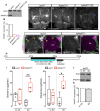AANAT1 functions in astrocytes to regulate sleep homeostasis
- PMID: 32955431
- PMCID: PMC7550187
- DOI: 10.7554/eLife.53994
AANAT1 functions in astrocytes to regulate sleep homeostasis
Abstract
How the brain controls the need and acquisition of recovery sleep after prolonged wakefulness is an important issue in sleep research. The monoamines serotonin and dopamine are key regulators of sleep in mammals and in Drosophila. We found that the enzyme arylalkylamine N-acetyltransferase 1 (AANAT1) is expressed by Drosophila astrocytes and specific subsets of neurons in the adult brain. AANAT1 acetylates monoamines and inactivates them, and we found that AANAT1 limited the accumulation of serotonin and dopamine in the brain upon sleep deprivation (SD). Loss of AANAT1 from astrocytes, but not from neurons, caused flies to increase their daytime recovery sleep following overnight SD. Together, these findings demonstrate a crucial role for AANAT1 and astrocytes in the regulation of monoamine bioavailability and homeostatic sleep.
Keywords: AANAT1; D. melanogaster; astrocytes; dopamine; monoamines; neuroscience; serotonin; sleep.
Plain language summary
Sleep is essential for our physical and mental health. A lack of sleep can affect our energy and concentration levels and is often linked to chronic illnesses and mood disorders. Sleep is controlled by an internal clock in our brain that operates on a 24-hour cycle, telling our bodies when we are tired and ready for bed, or fresh and alert to start a new day. In addition, the brain tracks the need for sleep and drives the recovery of sleep after periods of prolonged wakefulness – a process known as sleep-wake homeostasis. Chemical messengers in the brain such as dopamine and serotonin also play an important part in regulating our sleep drive. While dopamine keeps us awake, serotonin can both prevent us from and help us falling asleep, depending on the part of the brain in which it is released. Most research has focused on the role of different brain circuits on sleep, but it has been shown that a certain type of brain cell, known as astrocyte, may also be important for sleep regulation. So far, it has been unclear if astrocytes could be involved in regulating the need for recovery sleep after a sleep-deprived night – also known as rebound sleep. Now, Davla, Artiushin et al. used sleep-deprived fruit flies to investigate this further. The flies were kept awake over 12 hours (from 6pm to 6am), using intermittent physical agitation. The researchers found that astrocytes in the brains of fruit flies express a molecule called AANAT1, which peaked at the beginning of the night, declined as the night went on and recovered by morning. In sleep deprived flies, it inactivated the chemical messengers and so lowered the amount of dopamine and serotonin in the brain. However, in mutant flies that lacked AANAT1, both dopamine and serotonin levels increased in the brain after sleep deprivation. When AANAT1 was selectively removed from astrocytes only, sleep-deprived flies needed more rebound sleep during the day to make up for lost sleep at night. This shows that both astrocytes and AANAT1 play a crucial role in sleep homeostasis. Molecules belonging to the AANAT family exist in both flies and humans, and these results could have important implications for the science of sleep. The study of Davla, Artiushin et al. paves the way for understanding the mechanisms of sleep homeostasis that are similar in both organisms, and may in the future, help to identify sleep drugs that target astrocytes and the molecules they express.
© 2020, Davla et al.
Conflict of interest statement
SD, GA, YL, DC, SL, Dv No competing interests declared, AS Reviewing editor, eLife
Figures








Similar articles
-
Energetic demands regulate sleep-wake rhythm circuit development.Elife. 2024 Jul 22;13:RP97256. doi: 10.7554/eLife.97256. Elife. 2024. PMID: 39037919 Free PMC article.
-
Cloning of an arylalkylamine N-acetyltransferase (aaNAT1) from Drosophila melanogaster expressed in the nervous system and the gut.Proc Natl Acad Sci U S A. 1996 Oct 29;93(22):12315-20. doi: 10.1073/pnas.93.22.12315. Proc Natl Acad Sci U S A. 1996. PMID: 8901578 Free PMC article.
-
Genetic Dissociation of Daily Sleep and Sleep Following Thermogenetic Sleep Deprivation in Drosophila.Sleep. 2016 May 1;39(5):1083-95. doi: 10.5665/sleep.5760. Sleep. 2016. PMID: 26951392 Free PMC article.
-
Circadian Rhythms and Sleep in Drosophila melanogaster.Genetics. 2017 Apr;205(4):1373-1397. doi: 10.1534/genetics.115.185157. Genetics. 2017. PMID: 28360128 Free PMC article. Review.
-
Sleep and wakefulness in Drosophila melanogaster.Ann N Y Acad Sci. 2008;1129:323-9. doi: 10.1196/annals.1417.017. Ann N Y Acad Sci. 2008. PMID: 18591491 Free PMC article. Review.
Cited by
-
Mechanisms of Activation of Brain's Drainage during Sleep: The Nightlife of Astrocytes.Cells. 2023 Nov 20;12(22):2667. doi: 10.3390/cells12222667. Cells. 2023. PMID: 37998402 Free PMC article. Review.
-
The role of astrocyte-mediated plasticity in neural circuit development and function.Neural Dev. 2021 Jan 7;16(1):1. doi: 10.1186/s13064-020-00151-9. Neural Dev. 2021. PMID: 33413602 Free PMC article. Review.
-
speck, First Identified in Drosophila melanogaster in 1910, Is Encoded by the Arylalkalamine N-Acetyltransferase (AANAT1) Gene.G3 (Bethesda). 2020 Sep 2;10(9):3387-3398. doi: 10.1534/g3.120.401470. G3 (Bethesda). 2020. PMID: 32709620 Free PMC article.
-
The CHD8/CHD7/Kismet family links blood-brain barrier glia and serotonin to ASD-associated sleep defects.Sci Adv. 2021 Jun 4;7(23):eabe2626. doi: 10.1126/sciadv.abe2626. Print 2021 Jun. Sci Adv. 2021. PMID: 34088660 Free PMC article.
-
AANAT1 regulates insect midgut detoxification through the ROS/CncC pathway.Commun Biol. 2024 Jul 3;7(1):808. doi: 10.1038/s42003-024-06505-x. Commun Biol. 2024. PMID: 38961219 Free PMC article.
References
-
- Bacq A, Balasse L, Biala G, Guiard B, Gardier AM, Schinkel A, Louis F, Vialou V, Martres MP, Chevarin C, Hamon M, Giros B, Gautron S. Organic cation transporter 2 controls brain norepinephrine and serotonin clearance and antidepressant response. Molecular Psychiatry. 2012;17:926–939. doi: 10.1038/mp.2011.87. - DOI - PubMed
Publication types
MeSH terms
Substances
Grants and funding
LinkOut - more resources
Full Text Sources
Molecular Biology Databases

